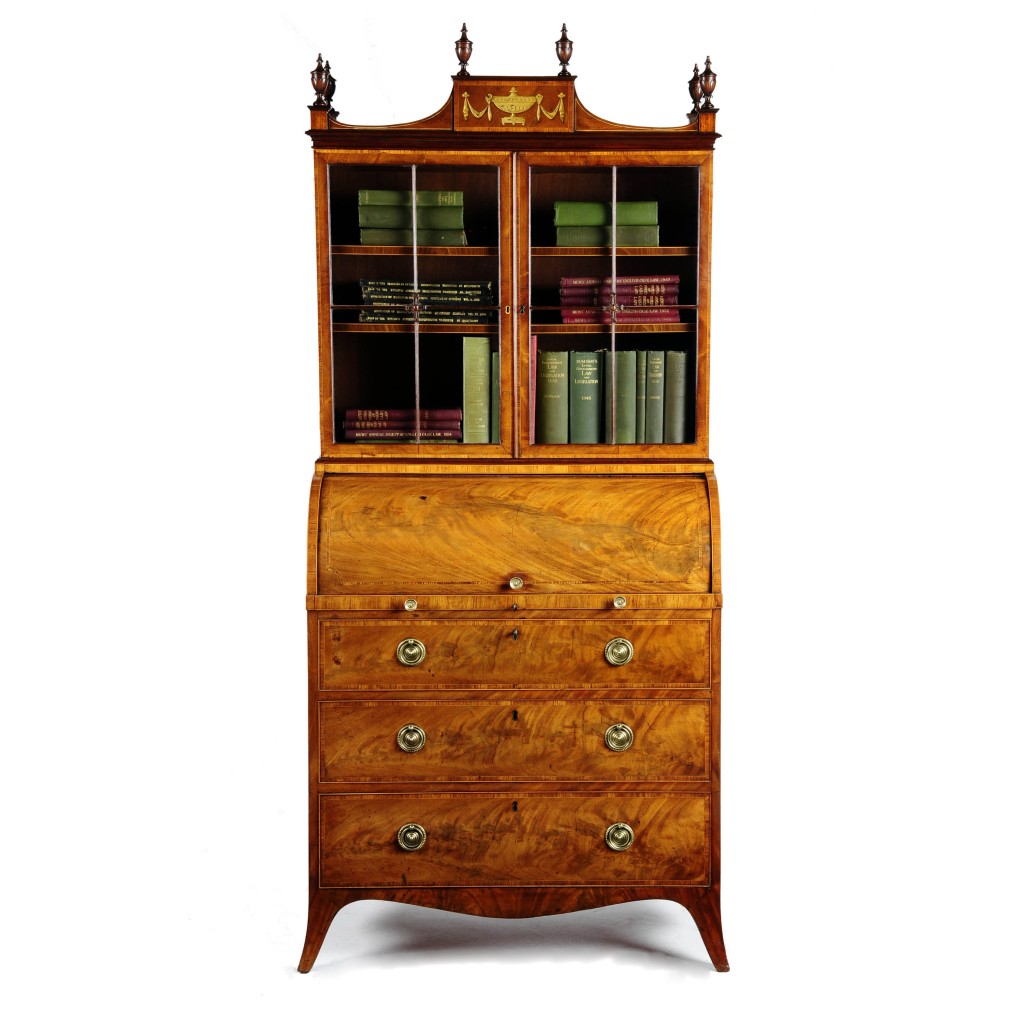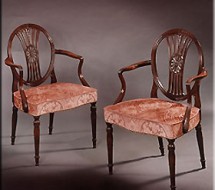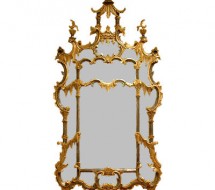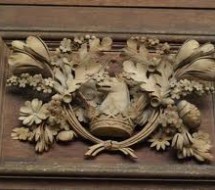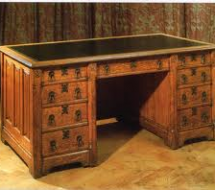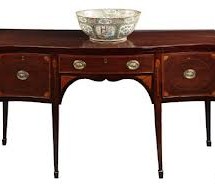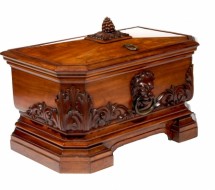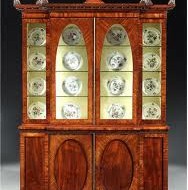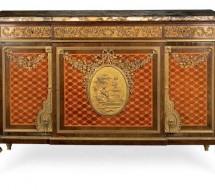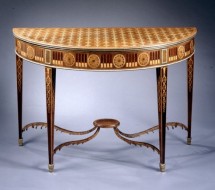Master Cabinetmakers
See Also: ArtlinkGlobal Auction News Advisories at:
http://artlinkglobaladvisory.wordpress.com/
See Also: ArtlinkGlobal Benchmarks for Designers at:
http://www.houzz.com/ideabooks/22926344
Robert ADAM
ADAM Robert and James Adam came of a Scottish family of architects and were born at Kirkaldy, in Fifeshire. Robert apparently took the leading part in affairs. He was born in 1728 and died in 1792. The brothers’ book of designs was published in 1775.
Brass inlay was occasionally used. The decorations on many tables were on the underframing. Ormolu escutcheons, knobs, handles and other fittings were largely employed. The tracery of doors and inlay panels was sometimes of diamond shape. Circular tapering legs as distinct from the square tapering legs of some of the other masters, were a feature. The “rainceau” style of decoration was much used by the Adam brothers. Some of the pieces were painted, other japanned in black and soft shades of slate and green with painted or gilt decorations on the polished surfaces.
The chair backs were often of oval or shield shape, and were usually padded. Some of the larger side tables have eight or even ten legs. Brass lattice-pattern grills were sometimes fitted to bookcase doors, in place of glass. The carvings or garnishments on Adam furniture usually had a centre ornament or patera, the latter being used in a large proportion of their designs. Papier-maché was employed in some cases in making door panels, candle brackets, etc. Some of the articles of furniture designed by the Adelphi, as the Adam brothers were sometimes called, were sideboards with taper pedestals, commodes, case-shaped knife cabinets, bookcases, girandoles, mirror-frames, tables, etc.
The Adam brothers revived the classical style, this class of ornamentation and design being represented in practically all their work. Celebrated artists such as Angelica Kauffmann, Zucchi, Cipriani and Pergolesi helped them in the decoration of rooms, the panels of furniture, table tops, etc. The Adam brothers may be said to be among the first to produce sideboards. Tables were first made with separate pedestals en suite, but later these were embodied. Amongst other forms or ornamentation used by them were painted and Jasper ware (Wedgwood) medallions, Greek and Roman vases, festoons, corn and tassel, anthemion, bows of ribbon, caryatids, rams’ heads, cupids, eagle-headed grotesques, winged sphinx lyres, pineapples, etc.
The inverted bell flower or husk was extensively used in the carved and gilt festooned decorations on the mirrors, etc., but apparently not so much on the chair legs, these usually being fluted and sometimes cable fluted. Mahogany and satinwood were largely used, being decorated with rich inlays, composed of such woods as amboyna, kingswood, tulipwood, etc., or painted by one of the famous artists who assisted in the brothers’ work.
Ferdinand Barbedienne
Ferdinand Barbedienne and Achille Collas, who was the inventor of a machine that would mechanically reduce statues, started the F. Barbedienne foundry in Paris in 1838. At first they produced bronze reductions of antique sculptures of Greek and Roman origin. Their first contract to produce bronzes modelled by a living artist was made in 1843 when they arranged to produce the works of Francois Rude. They barely survived the revolution and financial collapse of 1848, which caused many artists and foundries to declare bankruptcy. Barbedienne actively pursued contracts with the many sculptors of Paris contracting with David D’Angers, Jean-Baptiste Clesinger, and even producing some casts for Antoine Louis Barye as well as others.
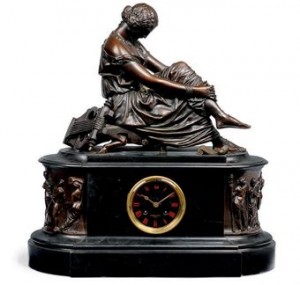
Achille Collas died in 1859 leaving Ferdinand Barbedienne as the sole owner of the foundry which by that time had grown to employ over 300 workers at their workshop located at 63 Rue de Lancry in Paris. Ferdinand Barbedienne was made the President of the Reunion of Bronze Makers in 1865 a post he held until 1885. The outbreak of the Franco-Prussian war in 1870 and the shortage of raw metals caused him to have to stop making sculptures but he did receive a contract from the French government for the production of cannons which kept his foundry open. After the war he resumed his casting of sculptures and put even more effort into signing contracts with various sculptors.
Thomas Chippendale
Chippendale, Thomas Was the son of a Worcestershire carver, and established himself in business in Conduit Street, London, in 1749, removing to more prominent premises in St Martin‘s Lane in 1752. His book, entitled “The Gentleman and Cabinet Maker’s Director” was published two years later. After his death in 1779 the business was carried on by his son in partnership with others at several addresses in London.
Chippendale is considered the master of perspective and proportion. The serpentine front was much employed. Stretcher rails were used only in chairs, etc., having square legs. The so-called “Irish Chippendale” presents a heavy appearance by comparison with genuine Chippendale. The carvings are not so sharp or deep, being flat and lifeless. Chased mounts and bands of brass, etc., were occasionally used as ornamentations. Many mid-18th Century pieces were gilt or japanned. Cupid as an ornamentation often appeared in the gilt mirrors, console tables, etc.
Wine coolers were produced in varying shapes, a common form being an octagonal brass-bound bucket with lid and zinc liner on a separate stand, usually with square, but sometimes with carved cabriole legs. Mahogany-framed wall mirrors were sometimes decorated with carved scrolls, cabochons, acanthus leaves, crockets, etc. Wine tables were made with carved edges and centre pieces for holding bottles, and mounted on tripod supports. The anthemion was represented in the cornices of some of the later pieces. Some of the square legs, particularly those of dining tables, had a sunk beading to their outside edges.
Chippendale furniture was not generally highly polished, being treated with an “oil polish” which left a somewhat dull finish. The tracery of bookcase doors often had the famous thirteen pane arrangement associated with Chippendale’s work. The lion’s-claw-and-ball foot is earlier than the eagle’s-claw-and-ball. Couches are not extensively made by Chippendale, but on those he produced the heads were generally in the form of chair backs and not adjustable. Péché mortels were occasionally made. The top or cresting rails of dining chairs were seldom, if ever straight, the line usually being broken at the ends, and/or in the centre. Some of the best chairs had the bottom edges of the front and side members shaped and ornamented.
Chippendale did not produce sideboards, but only side or carving tables, often fitted with marble tops. The cut through tern or cluster-column legs, chiefly appearing on cabinets and tables, were a feature of some of Chippendale’s Chinese designs. Tables with sunk or dish tops were much favoured. These sometimes had “pie crust” or “raised ribband” tops, the latter so called from the carved edge resembling ribbon.
Mahogany was discovered by Sir Walter Raleigh and was in general use by about 1720. It was the most popular wood in use, but rosewood was sometimes employed, and in some earlier pieces walnut, all on occasion being decorated with carvings. Many of Chippendale’s designs were influenced by the style of the corresponding French period, viz., Louise XV, and were elaborately carved in the rococo style. Chippendale seldom used inlay in his work but relied on delicate carvings, but such inlay as was used was only in the form of a lining or stringing; its presence usually denotes lateness of production.
“Chinese Chippendale”, a style in the Chinese taste, was principally represented in the fret (sometimes appliqué) and carved lattice ornamentations. This style was in vogue from about 1754 to 1770.
A favorite design for chair splats embodied the well-known “ribband” pattern, and others the letter “C” or “C” scroll. The “S” scroll was also employed in the earlier examples. The ladder back in another form. “Cupid’s-bow” was a favourite form for cresting rails.
Many pieces attributed to Chippendale were made by his contemporaries, such as Edwards and Darley, Ince and Mayhew, and others, especially articles in the Chinese taste. However, they may have been put out by Chippendale to be made, as at the height of his fame it is probable he had more orders to execute than could be carried out in his own workshops.
Chippendale made a great variety of articles, including bureau-bookcases, tripod and dining tables with two fixed and two hinged legs, two- and three-backed settees, card tables, some with give or six legs, commodes, tester or four-poster bedsteads, pole fire-screens, knife boxes, tea caddies, basin or wig stands, etc.
Grinling Gibbons
Gibbons, Grinling (1648-1721). An exceptionally gifted naturalistic carver famous for his cascades of lifelike blossoms, fruits, and foliage. Such decoration dominated 17th century interiors including Windsor Castle, Hampton Court Palace, St. Paul‘s Cathedral, as well as Badminton, Burghley, Petworth and other great country houses. Gibbons was appointed master carver to King George I.
Gillows & Co
Gillows & Co. A leading firm of English cabinet-makers, with premises in both Lancaster and London and who, during the 18th and 19th centuries, produced well-designed furniture of the highest quality. Founded in about 1727, the firm thrived by adapting to the needs of a changing society and recognized the potential offered by the expanding middle class market.
Gillows became a large company, both designing and manufacturing furniture to the very highest standards, so much so that they supplied the aristocracy and gentry of England at the height of the Empire. They had a ready response to fashionable demand and eventually led the way in the 19th century with some of the finest quality furniture ever produced in England.
George Hepplewhite
Hepplewhite, George (1721-86) Cabinetmaker and furniture designer whose designs in his posthumous book, Cabinet-Maker and Upholsterer’s Guide, published in 1788, epitomized the neo-classical style of the late 18th century. Some of the satinwood tables painted panels. Round shaped large handles were used.
The arms of the early elbow chairs were often padded. Square tapered legs were largely used. Hepplewhite is best known for his chairs and sideboards. A large number of his chairs were of shield shape. The strings of tapered bell flower or husks, the prince of Wales feathers, drapery, vases and wheatears were features in his carvings.
Holland & Sons
Originally founded in 1803 by Stephen Taprell and William Holland, a relation of the architect Henry Holland, the firm of Holland & Sons soon became one of the largest and most successful furniture making companies in the 19th Century. The firm worked extensively for the Royal Family, taking a leading part in the decoration and furnishing of Osborne House, Sandringham, Balmoral, Windsor Castle and the apartments of the Prince and Princess of Wales at Marlborough House.
Holland and Sons also Worked extensively for the British Government, for whom they executed over three hundred separate commissions, including the Palace of Westminster, the Victoria and Albert Museum, and the State funeral of the Duke of Wellington. Among their private commissions the firm produced a celebrated suite of bedroom furniture for the late Sir Harold Wernher at Luton Hoo.
Always at the forefront of fashion, Holland & Sons employed some of England‘s leading designers and participated in many of the most important international Exhibition of 1855 and the international exhibitions of 1862, 1867, 1872 and 1878.
Thomas Hope
Hope, Thomas (1770-1831). Art collector, author, architect and furniture designer whose name is synonymous with severe neo-classical form to this day.
He studied architecture and traveled extensively as a young man, settling in London in 1795 where he displayed his large collection of antique vases and sculpture in two homes, one in London on Duchess Street and one in Surrey, Deepdene. His published designs in Household Furniture and Decoration (1807) helped to expand the taste for the neo-Greek and Egyptian styles.
Francois Linke
Francois Linke (1855-1946) was perhaps the finest ebeniste and bronzier of the late 19th century. He moved from Bohemia to Paris in 1881 where he produced furniture of the highest quality at 170 rue du Faubourg- saint -Antoine, and later established showrooms at 26 Place Cvendome.
In praise of his highly individualistic technique, Linke was awarded a gold medal at the 1900 Paris exposition Universelle.
William Linnell
Linnell, William (1703-63) and John (1729-96). William, a carver, cabinetmaker and upholsterer, whose patrons included Sir Richard Hoare and his home at Barn Elms, for which he supplied furniture from 1739 to 1753.
He was succeeded by John, possibly his son or nephew, in 1763. Many of John’s designs for furniture are preserved in the Victoria and Albert Museum, and their best-known work is at Osterley Park and Shardeloes.
Thomas Sheraton
Sheraton, Thomas was born at Stockton-on-Tees in 1751 and published a book of designs in London in 1791. He is reputed to have died in poverty in 1806. Inlay work was extensively employed. Brass inlay was considerably used in the late English Empire pieces. Underframing or stretcher rails were seldom used in the chairs. The French style was lavishly imitated and brass finials were often used. The curved legs and tripod supports often had a small foot set vertically. Silver and Sheffield plate handles were occasionally employed, a common form for all handles being the oval. The oval was largely represented in the inlay work, and the serpentine front was successfully embodied in many pieces.
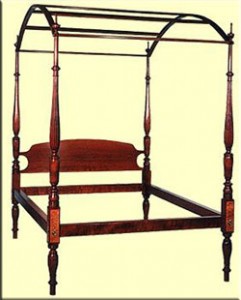
Deep cresting rails denote lateness of period, as does reeding in the legwork. The Prince of Wales’ feathers, vases and urns, shell designs and drapery were features of the carving, inlay and painted work. In chairs of the early period the splats did not reach the seats but were supported by a cross rail. The backs were usually composed of four, five or sometimes seven uprights.
A large quantity of the work produced was of the painted or japanned variety, decorated with painted designs. The underframings were often festooned and the leg fronts embellished with strings of flowers. Some pieces with a white ground and gold ornamentation. In some articles woven materials were used, e.g., in ladies’ work tables. These were described by him as “pouch” tables. Table supports and chair backs in the Empire style were often in the shape of a lyre, fitted with stout brass wire as strings. Marquetry took the place of much of the carved work seen in previous markers’ pieces. Acanthus leaves often appeared in the carvings, and “acanthus swags” were used to relieve the plainness of some of the members, being chiefly employed on chairs. The great majority of the legs were square tapered, but a few of the earlier pieces had turned legs. The square legs sometimes had fine inlay. Most of Sheraton’s designs mentioned satinwood, this apparently being his favourite wood, decorated with inlay or paintings by Angelica Kauffman, Cipriani, Pergolesi, etc. Mahogany was also extensively used, and occasionally rosewood and tulipwood. The inverted bell flower or husk was largely used by Sheraton in carvings, as by his predecessors; strings of them often ornament the fronts of chair legs etc. Veneering was resorted to whenever possible, but exposed members such as backs, legs, etc., were usually made of solid satinwood. Sheraton is reputed to be the inventor of the kidney-shaped table. It is at least evident that a large number in this shape were designed by him to meet various purposes. His chairs with shield-shaped backs have the line of the top rail broken, either by a straight line or panel in the centre, whereas this line is unbroken in the chairs produced by Hepplewhite. Square backs often have “X” rails in place of splats.
In a large number of cases Sheraton furniture was ingeniously fitted with secret doors and drawers and various semi-mechanical contrivances, such as mirrors, fitted to wash-stands and drawers, pivoted pen-troughs, writing slopes, library steps in the form of tables, all of which fold and slide away into concealed places. The “Harlequin” table is a typical example; in this a nest of pigeon holes and drawers can be raised from or lowered into the body of the table.
Sheraton is perhaps most famed for his sideboards. These are chiefly constructed of mahogany inlaid with satinwood, etc., and fitted with sundry conveniences. One style invariably had convex corners, this being the principal feature distinguishing them from those of Hepplewhite, which had concave corners. They were usually mounted on reeded tapered legs, and often had a brass back of “rainceau” design.
- Economist and Art Historian:
- Proprietary search, authentication and strategic implementation at auctions worldwide

